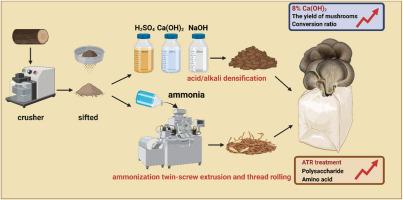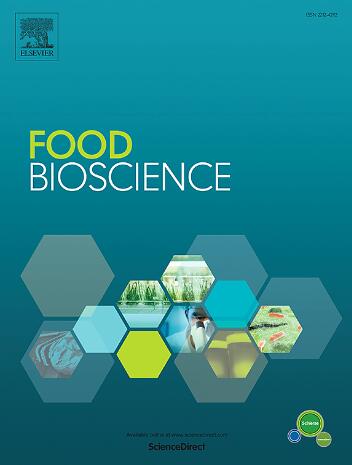木质纤维素碱致密预处理提高平菇产量的研究
IF 5.9
1区 农林科学
Q1 FOOD SCIENCE & TECHNOLOGY
引用次数: 0
摘要
平菇是一种营养丰富、蛋白质含量高的食用菌。它含有丰富的人体必需营养素,是可持续的功能性食品。传统的种植材料(玉米芯、秸秆)富含木质纤维素。然而,木质纤维素的稳定结构严重阻碍了木霉对这些材料的利用。本研究采用酸/碱致密化和氨化双螺杆挤压和螺纹滚压(ATR)技术,对培养基质进行预处理,然后将其用于ostreatus的培养。初步探讨了酸、碱试剂的附加浓度。筛选出的最佳浓度为H2SO4(5%)、Ca(OH)2(8%)和NaOH(8%)。通过对木质纤维素的组成和微观结构的分析,发现这些预处理方法可以有效地破坏木质纤维素的结构,而不影响其组分。进一步的研究表明,8% Ca(OH)2预处理更有利于白杨子实体的生长。结果表明,该处理可使产率提高28.30%,生物效率提高18.47%,干重提高24.32%,半纤维素降解率提高47.19%。同时,采用ATR对原料进行预处理更有利于提高青霉的营养价值。该方法可提高总氨基酸含量37.86%,粗多糖含量48.41%,蛋白质含量40.67%。本研究为青霉栽培中传统原料的创新预处理方法提供了新的见解。本文章由计算机程序翻译,如有差异,请以英文原文为准。

Alkali densification pretreatment of lignocellulose for improving the production of Pleurotus ostreatus
Pleurotus ostreatus is a mushroom characterized by rich nutrition and high protein content. It is abundant in essential nutrients for the human body and constitutes sustainable and functional food. The traditional cultivation materials (corn cobs, straw) for P. ostreatus are rich in lignocellulose. However, the stable structure of lignocellulose seriously hinders the utilization of these materials by P. ostreatus. In this study, we adopted acid/alkali densification and ammonization twin-screw extrusion and thread rolling (ATR), to pre-treat cultivation substrates before using them for the cultivation of P. ostreatus. The additional concentrations of acid and alkali reagents were initially investigated. The optimal concentrations were screened out as H2SO4 (5 %), Ca(OH)2 (8 %), and NaOH (8 %). Through the analysis of the composition and microstructure of lignocellulose, it was discovered that these pretreatment methods could effectively disrupt the structure of lignocellulose without exerting any influence on its components. Further studies revealed that the pretreatment with 8 % Ca(OH)2 was more favorable for the growth of P. ostreatus fruiting bodies. This approach increased the total yield of P. ostreatus by 28.30 %, enhanced the biological efficiency by 18.47 %, raised the dry weight by 24.32 %, and elevated the degradation rate of hemicellulose by 47.19 %. Meanwhile, the pretreatment of raw materials with ATR was more conducive to improving the nutritional value of P. ostreatus. This method increased the total amino acid content by 37.86 %, the crude polysaccharide content by 48.41 %, and the protein content by 40.67 %. This study offers novel insights into the innovative pretreatment approaches for traditional raw materials used in P. ostreatus cultivation.
求助全文
通过发布文献求助,成功后即可免费获取论文全文。
去求助
来源期刊

Food Bioscience
Biochemistry, Genetics and Molecular Biology-Biochemistry
CiteScore
6.40
自引率
5.80%
发文量
671
审稿时长
27 days
期刊介绍:
Food Bioscience is a peer-reviewed journal that aims to provide a forum for recent developments in the field of bio-related food research. The journal focuses on both fundamental and applied research worldwide, with special attention to ethnic and cultural aspects of food bioresearch.
 求助内容:
求助内容: 应助结果提醒方式:
应助结果提醒方式:


